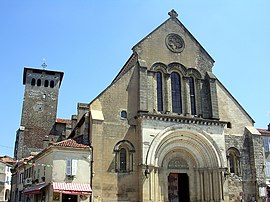Saint-Sever
show This article may be expanded with text translated from the corresponding article in French. (April 2010) Click [show] for important translation instructions. |
Saint-Sever | |
|---|---|
 Abbey church | |
 Coat of arms | |
show Location of Saint-Sever | |
 Saint-Sever | |
| Coordinates: 43°45′27″N 0°34′23″W / 43.7575°N 0.5731°WCoordinates: 43°45���27″N 0°34′23″W / 43.7575°N 0.5731°W | |
| Country | France |
| Region | Nouvelle-Aquitaine |
| Department | Landes |
| Arrondissement | Mont-de-Marsan |
| Canton | Chalosse Tursan |
| Government | |
| • Mayor (2020–2026) | Arnaud Tauzin |
| Area 1 | 46.96 km2 (18.13 sq mi) |
| Population (Jan. 2018)[1] | 4,966 |
| • Density | 110/km2 (270/sq mi) |
| Time zone | UTC+01:00 (CET) |
| • Summer (DST) | UTC+02:00 (CEST) |
| INSEE/Postal code | 40282 /40500 |
| Elevation | 26–118 m (85–387 ft) |
| 1 French Land Register data, which excludes lakes, ponds, glaciers > 1 km2 (0.386 sq mi or 247 acres) and river estuaries. | |
Saint-Sever (French pronunciation: [sɛ̃səve], Gascon Sent Sever [sensebe][2]) is a commune in the Landes department in Nouvelle-Aquitaine in southwestern France.
History and geography[]
This section needs expansion. You can help by . (April 2010) |

Saint-Sever stands on an eminence. It is 17 km (11 mi) south of Mont-de-Marsan, on the left bank of the Adour in the Chalosse area.
Neighboring communes: Benquet, Bas-Mauco, Audignon, Cauna, Aurice, Montaut, Banos, Coudures, Eyres-Moncube, Montsoué, Montgaillard.
The town's abbey was founded by Guillaume Sanche lord of Gascony in the late 10th century. According to the monastic chronicles, this was as the result of a vow he made after the battle of Taller, in Gascony, in which he defeated the Vikings (982). In 1060, after a fire, the abbey was reconstructed on the model of Cluny under the direction of the abbot Gregori de Montaner. The Saint-Sever Beatus was the work of monks working under the direction of the same abbot; Abbot Gregori held the post from 1028 to 1072.
Sights[]
Its streets, bordered in places by old houses, are narrow and winding. The promenade of Morlanne laid out on the site of a Roman camp called commands a fine view of the Adour and the pine forests of the Landes.

The church of Saint-Sever, a Romanesque building of the 12th century, with seven apses, once belonged to the Benedictine abbey founded in the 10th century. The abbey of Saint-Sever was added to the UNESCO World Heritage Sites in 1998, as part of the World Heritage Sites of the Routes of Santiago de Compostela in France.
The convent and cloister of the Jacobins (13th century), a Dominican convent, built of pink bricks; now contains the Jacobins Museum (exhibits include rocks and illuminations from the Saint-Sever Beatus).
Population[]
|
|
Sights[]

The public institutions of the town include the sub-prefecture, a tribunal of first instance, and a practical school of agriculture and viticulture which occupies a former Dominican convent.
See also[]
References[]
- INSEE statistics
- This article incorporates text from a publication now in the public domain: Chisholm, Hugh, ed. (1911). "St Sever". Encyclopædia Britannica. 24 (11th ed.). Cambridge University Press. p. 45.
- ^ "Populations légales 2018". INSEE. 28 December 2020.
- ^ Presentation of the town (official homepage of Saint-Sever).
| Wikimedia Commons has media related to Saint-Sever. |
- Communes of Landes (department)
- World Heritage Sites in France


